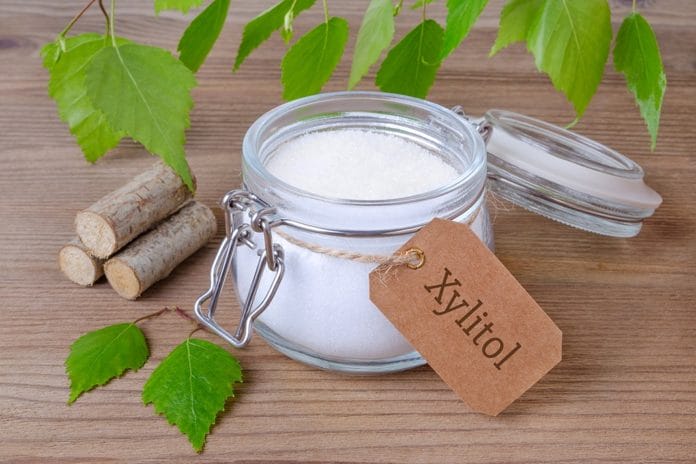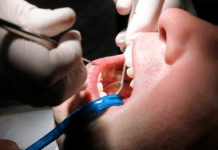Xylitol, the sweetener with a twist; this little 5-carbon molecule packs a punch of health benefits. Xylitol is a natural sweetener which has properties that have been shown to prevent tooth decay, increase salivary production, and reduce the development of bacteria in the mouth.1 Research shows that five exposures to xylitol a day can significantly inhibit bacterial growth in the oral cavity.2 Instead of bad oral bacteria (i.e., Streptococcus mutans) multiplying each day exponentially, it is reduced significantly and at a significant rate with the use of xylitol.3 This is because xylitol is a 5-carbon molecule; bacteria cannot properly metabolize it and in essence “starve.” Fructose, glucose, and sorbitol are 6-carbon molecules which bacteria are able to metabolize and, hence, reproduce exponentially.
Xylitol is a sugar alcohol that has been used as a sugar substitute since ancient times where it was most likely ingested in its natural forms such as from Birch bark or corn cobs. Xylitol was first synthesized in 1891 in Europe where sadly, it was forgotten. World War II rationing of sugar led to the re-emergence of xylitol as a sugar substitute.4 Surprisingly, the United States has not yet fully embraced this wonderful natural sweetener. The name xylitol is derived from Ancient Greek: xyli “wood” + itol “used to denote sugar alcohols.” It is most commonly produced from Birch tree bark and corn cobs, but trace amounts are also found in strawberries, plums, cauliflower, and pumpkin.4
The recommended dosing for caries prevention is 5 exposures (doses) per day: 1 piece of xylitol gum = 1 dose, 2 xylitol mints = 1 dose. Besides the benefits of reducing caries, it also stimulates salivary flow which can be a life-saver to someone who suffers from chronic med-induced dry mouth (xerostomia).5 Research also shows a connection between chewing xylitol gum or using a xylitol syrup in the prevention of ear aches amongst healthy children.6
With diabetes being so proliferate in today’s society, xylitol provides a safe alternative to sugar. Xylitol causes lower blood glucose and lowers insulin responses compared to foods sweetened with sorbitol and/or regular sugar.5 In large doses, xylitol may cause some gastric distress; however, if proper dosing is used xylitol is very safe and effective. Approximately 50% of ingested xylitol is not absorbed by the intestines, instead, it is fermented by gut bacteria to short-chain acids and gasses. Some bloating and discomfort may occur if proper dosing is not followed.7
Without going into great scientific detail, studies are showing that xylitol may also have promise in the prevention of oral cancer, lung cancer, and weight reduction. Think of the positive implication this could mean for your patients who smoke. Perhaps suggesting xylitol gum in the place of a cigarette up to five times a day would be an encouraging attempt at smoking cessation. As a matter of fact, I have done an Action Research paper on this very topic and found some promising results, limited, but successful. With so many positive benefits, xylitol remains an obvious recommendation of choice for so many preventive purposes.
One of the xylitol products that I personally love and recommend is xylitol nasal spray. As a clinician, I have had several patients return at their six-month recare appointments with great praise for the recommended product. Just last week I saw a 43-year-old male patient (we will call Jake) who thanked me profusely for recommending xylitol nasal spray at his last check-up. I asked Jake what made him listen to my recommendation and he stated that he simply had to. You see, when I first seated Jake, I noticed his “long-in-the-face” appearance, his droopy eyes with dark rings, and his open-mouth posture. I asked Jake if he had trouble sleeping at night, if he snored, and if he could breathe through his nose. Jake could not breathe through his nose, so he did not sleep well and snored every night.
Upon asking Jake if he had any sinus drainage, he stated that his drainage was so bad that he literally vomited every morning and simply could not thoroughly brush his teeth due to his exaggerated gag reflex. I suggested Jake try xylitol nasal spray (2 squirts each nostril day and night) to see if it may reduce the bacteria population that had taken over his nasal septum for years, as Jake did not remember a time that he could breathe through his nose. Jake started using his xylitol nasal spray and stated that he had instant results and has not vomited since using the product. He bought more xylitol nasal spray so he could have some at work, in his bedroom, and the bathroom. Jake believed me because I could read his problem with a simple glance of his face; therefore, he listened to my suggested recommendation.
If you, a patient, or a loved one suffer from xerostomia, I highly recommend xylitol mints or chewing gum to promote salivary flow and protect against rampant decay. The xylitol will also promote a smooth and clean feeling resulting in immediate relief from the angst of dry-mouth-syndrome. With the reduction of bacteria as an added benefit, how can we overlook this sweetener with a twist! Xylitol products can be found online as well as at your favorite health food store. They include crystallized granules (to be used in place of table sugar), gums, mints, toothpaste, rinses, and syrups.
To me, Jake’s story is why I love clinical dental hygiene, changing lives for the better! So yes, I am a true believer in xylitol as a health product and dental hygienists as oral health promoters. This is a good example of the systemic link between oral health and whole body health.
*Warning to dog-owners! Xylitol can make your pooch fatally sick if ingested in doses greater than 500 to 1000 mg per kilogram body weight. It could cause hypoglycemia or worse yet, fatal liver damage.8 This is a very large dose; however, dogs will be dogs! Please keep your xylitol out of reach of your canine friend. Call your vet ASAP if ingested. It is always good to have a dextrose supplement (corn syrup) on hand as a potential counteractive antidote to give the time needed to reach the vet.
SEE ALSO: All About Xylitol: The New Sugar, Sweetness with Benefits!
Now Check Out the Peer-Reviewed, Self-Study CE Courses from Today’s RDH!
Listen to the Today’s RDH Dental Hygiene Podcast Below:
References
- Riley, P., Moore, D., Ahmed, F., Sharif, M., Worthington, H. Xylitol-containing products for preventing dental caries in children and adults. The Cochrane Database of Systematic Reviews. 26 March 2015: (3)CD010743. Retrieved from https://www.cochranelibrary.com/cdsr/doi/10.1002/14651858.CD010743.pub2/full
- Slot, D., Rosema, N., Van Loveren, C., Vander Weijden, G. Effects of sugar-free chewing gum sweetened with xylitol or maltitol on the development of gingivitis and plaque: a randomized clinical trial. International Journal of Dental Hygiene. 21 March 2014: 12(4): 238-244. Retrieved from https://www.ncbi.nlm.nih.gov/pubmed/24650323
- Zhou, X., Li, Y. From healthy microflora to disease. Atlas of Oral Microbiology. 2015. Pg.8.
- Ur-Rehman, S., Mushtaq, Z., Zahoor, T., Jamil, A., Murtaza, M. Xylitol: a review on bioproduction, application, health benefits, and related safety issues. Critical Reviews in Food Science and Nutrition. 2015: 55(11): 1514–28. Retrieved from https://www.tandfonline.com/doi/full/10.1080/10408398.2012.702288
- Makinen, K. Can the pentitol-hexitol theory explain the clinical observations made with xylitol? Medical Hypothesis. April 2000: 54(4): 604-613. Retrieved from https://www.sciencedirect.com/science/article/pii/S0306987799909040?via%3Dihub
- Azarpazhooh, A., Lawrence, H., Shah, P. Xylitol for preventing acute otitis media in children up to 12 years of age. The Cochrane Database of Systematic Reviews. 3 August 2016: (8):CD007095. Retrieved from https://www.cochranelibrary.com/cdsr/doi/10.1002/14651858.CD007095.pub3/full
- Livesey G. Health potential of polyols as sugar replacers, with emphasis on low glycaemic properties.Nutrition Research Reviews. 2003: 16(2): 163-191. Retrieved from https://www.cambridge.org/core/journals/nutrition-research-reviews/article/health-potential-of-polyols-as-sugar-replacers-with-emphasis-on-low-glycaemic-properties/51B0744C8573925A7A74FF2AD87429F9
- Dunayer E. New findings on the effects of xylitol ingestion in dogs.(PDF). Veterinary Medicine. 2006: 101(12): 791–797. Retrieved from https://web.archive.org/web/20130617144130/http:/files.meetup.com/556343/xylitol%20in%20dogs.pdf












